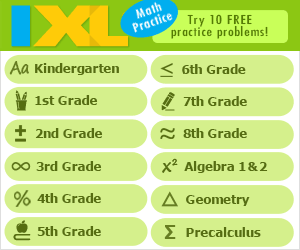8th Grade Science Standards - Physical Science
Links verified September 20 & 21 of 2014
Checks for Understanding (Formative/Summative Assessment)
0807.9.1 Atoms - Identify atoms as the fundamental particles that make up matter 0807.9.2 States of Matter - Illustrate the particle arrangement and type of motion associated with different states of matter 0807.9.3 Measure - Measure or calculate the mass, volume, and temperature of a given substance 0807.9.4 Density - Calculate the density of various objects 0807.9.5 Element or Compound - Distinguish between elements and compounds by their symbols and formulas 0807.9.6 Physical or Chemical - Differentiate between physical and chemical changes 0807.9.7 Component Parts - Describe how the characteristics of a compound are different than the characteristics of their component parts 0807.9.8 Interactions - Determine the types of interactions between substances that result in a chemical change 0807.9.9 Mixture of Gas - Explain how the chemical makeup of the atmosphere illustrates a mixture of gases 0807.9.10 Periodic Table - Identify the atomic number, atomic mass, number of protons, neutrons, and electrons in an atom of an element using the periodic table 0807.9.11 Conservation of Mass - Use investigations of chemical and physical changes to describe the Law of Conservation of Mass 0807.9.12 Chemical Reaction - Differentiate between the reactants and products of a chemical equation 0807.9.13 Acid or Base - Determine whether a substance is an acid or a base by its reaction to an indicator 0807.12.1 Electricity and Magnetism - Create a diagram to explain the relationship between electricity and magnetism 0807.12.2 Electromagnet - Produce an electromagnet using a bar magnet and a wire coil 0807.12.3 Electromagnet Strength - Experiment with an electromagnet to determine how to vary its strength 0807.12.4 Magnetic Fields - Create a chart to distinguish among the earth's magnetic field, and fields that surround a magnet and an electromagnet 0807.12.5 Mass and Weight - Explain the difference between mass and weight 0807.12.6 Gravitational Force - Identify factors that influence the amount of gravitational force between objects 0807.12.7 Motion of Objects - Explain how the motion of objects in the solar system is affected by gravity State Performance Indicators
SPI 0807.9.1 Matter - Recognize that all matter consists of atoms SPI 0807.9.2 Chemical Change - Identify the common outcome of all chemical changes SPI 0807.9.3 Classify Substances - Classify common substances as elements or compounds based on their symbols or formulas SPI 0807.9.4 Mixture or Compound - Differentiate between a mixture and a compound SPI 0807.9.5 Atmosphere - Describe the chemical makeup of the atmosphere SPI 0807.9.6 Particle Motion - Compare the particle arrangement and type of particle motion associated with different states of matter SPI 0807.9.7 Density Equation - Apply an equation to determine the density of an object based on its mass and volume SPI 0807.9.8 Interpret Results - Interpret the results of an investigation to determine whether a physical or chemical change has occurred SPI 0807.9.9 Element Properties - Use the periodic table to determine the properties of an element SPI 0807.9.10 Reactants and Products - Identify the reactants and products of a chemical reaction SPI 0807.9.11 Law of Conservation - Recognize that in a chemical reaction the mass of the reactants is equal to the mass of the products (Law of Conservation of Mass) SPI 0807.9.12 Properties of Acids or Bases - Identify the basic properties of acids and bases SPI 0807.12.1 Production of Electricity - Recognize that electricity can be produced using a magnet and wire coil SPI 0807.12.2 Principles of Electromagnet - Describe the basic principles of an electromagnet SPI 0807.12.3 Earth's Magnetic Field - Distinguish among the Earth's magnetic field, a magnet, and the fields that surround a magnet and an electromagnet SPI 0807.12.4 Measuring Mass and Weight - Distinguish between mass and weight using appropriate measuring instruments and units SPI 0807.12.5 Gravitational Attraction - Determine the relationship among the mass of objects, the distance between these objects, and the amount of gravitational attraction SPI 0807.12.6 Motion in Space - Illustrate how gravity controls the motion of objects in the solar system
Search Internet4Classrooms

Custom Search






